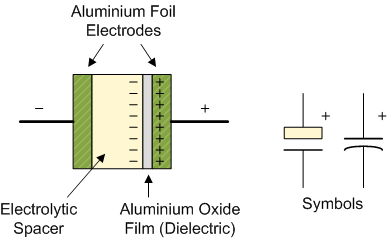This application of aluminum foil employs not only its good electrical conductivity but also its oxidecoating, specially formed (anodized) to make a superior dielectric layer between the two conductors. The dielectric constant of aluminum oxide is higher than that of waxed paper and many other dielectric materials, therefore it can store more electrons per unit of area. The oxide dielectric plate, which determines the size of a given capacitor, does not have to be as large as a paper dielectric "plate" for an equal capacity. Further, the oxide film, even a "thick" one, is thinner than the thinnest tissue paper. This thin film of aluminum oxide reduces the bulk of the capacitor; but more important, its thinness also increases the capacitance per unit of area. Another advantage of aluminum foil for electrolytic capacitors is that the foil is readily etched. This is important because etching greatly increases the true surface area which, when anodized, results in a far larger dielectric plate capacity.

There are basically two types of Aluminium Electrolytic Capacitor, the plain foil type and the etched foil type. The thickness of the aluminium oxide film and high breakdown voltage give these capacitors very high capacitance values for their size.
The foil plates of the capacitor are anodized with a DC current. This anodizing process sets up the polarity of the plate material and determines which side of the plate is positive and which side is negative.
The etched foil type differs from the plain foil type in that the aluminium oxide on the anode and cathode foils has been chemically etched to increase its surface area and permittivity. This gives a smaller sized capacitor than a plain foil type of equivalent value but has the disadvantage of not being able to withstand high DC currents compared to the plain type. Also their tolerance range is quite large at up to 20%. Typical values of capacitance for an aluminium electrolytic capacitor range from 1uF up to 47,000uF.
Etched foil electrolytic’s are best used in coupling, DC blocking and by-pass circuits while plain foil types are better suited as smoothing capacitors in power supplies. But aluminium electrolytic’s are “polarised” devices so reversing the applied voltage on the leads will cause the insulating layer within the capacitor to become destroyed along with the capacitor. However, the electrolyte used within the capacitor helps heal a damaged plate if the damage is small.
Since the electrolyte has the properties to self-heal a damaged plate, it also has the ability to re-anodize the foil plate. As the anodizing process can be reversed, the electrolyte has the ability to remove the oxide coating from the foil as would happen if the capacitor was connected with a reverse polarity. Since the electrolyte has the ability to conduct electricity, if the aluminium oxide layer was removed or destroyed, the capacitor would allow current to pass from one plate to the other destroying the capacitor.